Almost every cruising boat, including us, seems to underestimate the amount of electricity we use per day when planning alternative energy – for us solar panels and wind generator. Very frustrating when your goal is to live by the sun and wind and not have to run the diesel or generator daily!
DISCLAIMER: I am NOT an electronics guru – I don’t really understand much of this stuff other than basic principles. What I DO know is that our alternative energy has NEVER kept up with our electrical consumption and this analysis shows why! 🙂 Keep in mind the power usage figures I’m using is what we’ve determined by using our Link 10 and turning things on & off to isolate individual items – not necessarily what’s quoted by the manufacturer. Hopefully, unlike us, you’ll figure out your alternative energy needs BEFORE you spend six years cruising frustrated every morning by the morning ritual of “how can we POSSIBLY be down that many amps!!!” 🙂
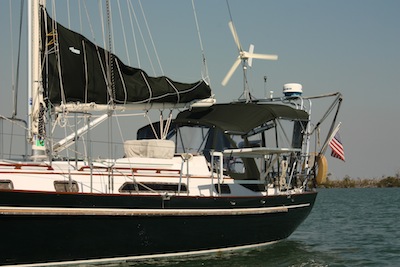
Before you can start to plan for a cruising vessel’s alternative energy plan, you need to know how many amp hours of electricity you use each day. Do you need to replace 100 amp hours … or 150 …. or 200 ??? Unfortunately there’s no shortcut easy way to calculate this information — I can’t tell you because it’s vastly different for every cruising boat. Even individual systems, such as radar, can consume vastly different amounts of juice based on how old they are (ours are ancient) and a variety of other factors, so there’s no one size fits all equation.
When we started outfitting Winterlude, we had a 55 amp alternator with our 30 hp diesel engine and that was it. No alternative energy at all. We didn’t pay as much attention as we should have to our alternative energy plan, and as a result, on an average we only replace about half of our daily usage via alternative energy. Entirely preventable if you plan correctly.
STEP 1:
 The first step is to calculate how many amps you use daily. To do this, you must go through meticulously and calculate amp usage by hours used by anything aboard. If you don’t know how to calculate amp usage for each individual thing that uses electricity, you’re going to have to be a bit of a sleuth – you need to find the watts and voltage for each light bulb, each appliance and so on. Most packaging will contain the information you need, often you can look it up online. As an example, look on the bottom of an appliance – here’s our coffeepot. You can see that it uses 1425 watts and it’s 120 volts. WATTS divided by VOLTAGE = AMPS is the formula. So 1425 divided by 120 = approximately 12 amp hours PER HOUR.
The first step is to calculate how many amps you use daily. To do this, you must go through meticulously and calculate amp usage by hours used by anything aboard. If you don’t know how to calculate amp usage for each individual thing that uses electricity, you’re going to have to be a bit of a sleuth – you need to find the watts and voltage for each light bulb, each appliance and so on. Most packaging will contain the information you need, often you can look it up online. As an example, look on the bottom of an appliance – here’s our coffeepot. You can see that it uses 1425 watts and it’s 120 volts. WATTS divided by VOLTAGE = AMPS is the formula. So 1425 divided by 120 = approximately 12 amp hours PER HOUR.
THE INVERTER FACTOR
HOWEVER, it’s not this simple — of course not! There’s nothing worse than running the noisy Honda 2000 generator before I even get my first cup of coffee! So, we use the inverter. Ours is modified sine wave and we’re lucky we’ve never had anything electronic break – a better choice for us would be pure sine wave, but it still works, so se la vie. Problem is, all inverters are different but ALL inverters waste power – it gets really really complicated to calculate how much wasted power there is in converting DC to AC so we use a “wasted” ratio of 2 to 1 — i.e. it takes twice as many DC amps to power that AC through the inverter. So for items powered via the inverter, I double the amps usage. I know this is not scientific, but it seems to come pretty close for our alternative energy calculations – if you’re more technical than I, feel free to jump in and let us know a better way to do this by leaving a comment below!

Here’s our at anchor list as a starting point, note that you need to know amps per hour AND an estimate of how many hours you use the item to calculate daily amp usage.
LED Anchor Light .25/hour X 10 hours = 2.5 amps/night
Adler Barber Cold Plate – Refrigerator & Freezer 6 amps/hour X 24 hours = 144 amps/day (theoretically it cycles on & off, which it does, but it still seems to take between 120 – 150 amps a day)
Bilge Pump: 3 amps/hour X 5 minutes + .25/day
Sensibulb LED Interior Lights: avg 3 lights on for 3 hours each = .20 amps/hour X 9 = 2 amps/day
VHF Radio: 6 amps transmit/ .5 amps receive – 12 hours = 6 amps + 10 minutes talk time = 1 amp = 7 amps total
SSB Radio: 1 hour receive @ 3 amps/10 minutes talk time @ 30 amps = 8 amps total
(NOTE: Both radios are different based on whether we’re using low power or high power, these are just guesstimate averages)
Coffee Pot: 6 cups of coffee – 3 amps each (including the inverter) = 18 amps

Cabin Fans: 2 amps/hour X 2 hours each or 4 hours = 8 amps (obviously if it’s hot and we run the pullman berth fan all night we use 20 amps, we probably need to replace these fans with more energy efficient fans, but they move SO much air!!)
Laptop Computer: 2 hours/day 5 amps/hour = 10 amps
Printer: 10 minutes/day at .35/hour
Charging Stuff (from phones to drills to handheld VHF’s etc): 5 amps/day average
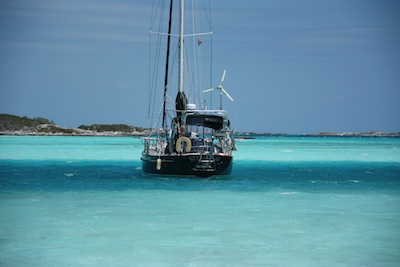
So you can see with just the basic daily “stuff” we run, we average over 200 amps a day. Unfortunately, we only have 4 55 watt solar panels and a KISS Wind Generator. Figuring 14.5 amp hours from our solar (my simplified rule of thumb is 1 amp per every 15 watts) – and there are maybe 4 total hours when we generate max amps – so 14 amps X 4 hours = 56 amps, plus less for the remaining 5 hours or another 25 amps – total solar on a good day is 81 amps. Significantly short of our 200 amps/day usage. YIKES! Add wind — if it’s blowing 12 knots, we get maybe 3-4 amps/hour for a total of 72 amps a day – and rarely do we ever see this many amps in a day from the wind generator. Under perfect conditions, with our alternative energy choices, we would add 153 amps — and we’re using over 200. Bottom line is we can go about 3 days without having to use either our Honda 2000 portable generator or the diesel to recharge our 6 Trojan T105 wet cell batteries.
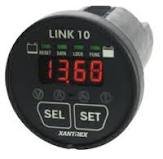
We didn’t do our homework well enough when equipping the boat for alternative energy! If we did it over again, we’d have at least 450 watts of solar – or 30 amps/hour from 450 watts or 120 amps from peak hours and another 55 from off peak hours = 174 amps on a good day for solar, plus the 72 from the wind generator for a total of 246 amp hours a day. Unfortunately perfect days are rare, but with 450 watts of solar and the wind generator, we should be able to keep up with our 200 amp daily usage.
Other stuff:
Spectra Catalina 300 Watermaker: 15 amps/hour, 13 gallons/hour takes 3-4 hours to fill one tank or 52+ amps – we usually run the Honda 2000 or make water underway. Technically we CAN make water using our alternative energy and sometimes do if the wind is blowing 15-18 and we’re generating significant wind amps as well as solar.
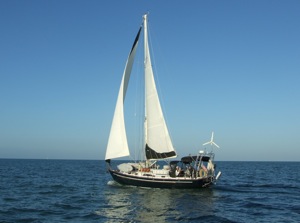
Don’t forget to calculate an under sail version of this same analysis – underway we run our navigation lights (since we’ve switched to LED, these are not a big draw, but before we switched they were HUGE – don’t leave them out of your analysis), our radar close to shipping lanes, our GPS – actually 2, a Garmin 541 at the helm and our laptop consistently for the Nobeltec electronic charts plus our Tridata Depth, Wind & Speed instruments. Update: if we were to do the electronics over again, we’d include AIS, so that’s another energy draw underway … who knows, we may add one soon anyway! 🙂
If we’re sailing these add up – especially the laptop with it’s 5 amps an hour draw = 120 per 24 hour period, plus another 7 per hour below = 288 amp hours in 24 hours NOT including the daily stuff such as the refrigerator…. YIKES! We limit the amount of time we need the laptop and radar actually running since we have a Garmin at the help and the radar only needs to be on if we’re dodging either ships or thunderstorms.

One last point …. we don’t include our electric windlass, electric autopilot or other items that are only used when the diesel is running because the alternator is charging and we’re not draining our batteries. If you use an electric autopilot underway when SAILING, not under power, then you’ll need to calculate the usage because they can be huge amp hogs & you don’t want to run your batteries down while enjoying your sail!
Please leave a comment and chime in to the discussion! THANKS! Jan
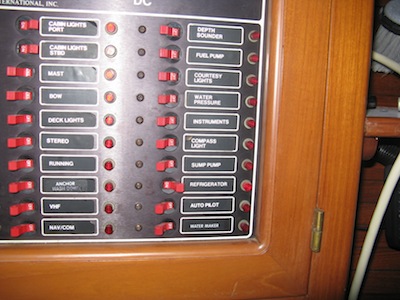
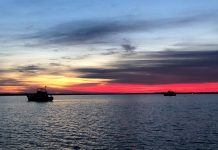










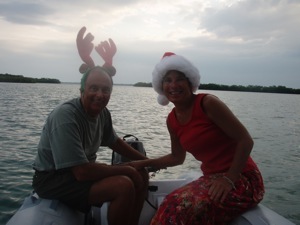

Thank you very much for such an informative article, just at the right time for us. I was just about to post a question on this exact topic and this has given me enough to ponder over before I post a question.
My wife and I are currently selling up our home, motorhome and all our worldly possessions here in the UK in order to realise our dream of sailing the Caribbean and East Coast of the USA (Of course once we are more confident and proficient with the yacht we decide on and of course once we have plucked up the courage, we might do a “crossing of the pond”) lol.
Hi Len! I’m glad the post was helpful! Good luck with your lifestyle change — it’s amazing to be able to change your neighborhood and get involved with new cultures by merely raising the sails! Of course, you probably have somewhat of that with your motorhome, but we have no experience there! 🙂 Cheers! Jan
Jan – Thanks for taking the time and effort to put this information together. Extremely helpful! My wife and I were having our “alternative energy” conversation again last night. We will be interested to see the thoughts and input of others.
Len – We just finished eliminating all of our land-based life style “stuff” in July and are l
Icing aboard full-time. The hassle is worth it. Good luck.
Thanks Dave! It’s such a complicated subject and I’m sure I don’t have all the details exact, BUT I do know every morning we grumble about not taking the time to determine we needed 450 amps of solar BEFORE we left the US! 🙂 Cheers! Jan
This is some really good information! Thanks for sharing your experiences. It’ll definitely come in handy when my wife and I start setting up our own boat.
Hi Jan,
We are currently re-configuring our alternative energy sources and I found your article helpful! Quick question: How many charge controllers do you have on board? Do you have one for each solar panel?
Hi Michelle – we do not have a charge controller for each solar panel. They are configured together with a Solar Boost 2000E MPPT charge controller. It will take up to I think 350 watts and we currently have 225 in it. We’re seriously thinking about adding another 100 watts since we can configure them through the same controller. Good luck!
This site was… how do I say it? Relevant!! Finally I have found something which helped me. Thank you!
Keep this going please, great job!
There’s certainly a lot to know about this subject. I love all of the points you made.
Things are never as simple as they first seem. It looks like you’ve done a thorough job though.
On the inverter, the manufacturer should be able to get you figures on expected output vs input. They don’t like to publish efficiencies probably because they would scare off customers. Going from lower voltage in to higher voltage out or from DC in to AC out will waste a lot of power. Sometimes you just have to do it though. The more power they waste, the hotter they run, just something to keep in mind.
Not sure if this thread is still active, but here goes;
Last month I was hit with this problem, fortunately it was only on an 100NM overnight trip (my 2nd ever, and mileage towards the next skipper level), but it got me thinking nonetheless. I’ve actually thought about it many times before, but only when I woke up just before dawn to no nav equipment or sailing lights, did I get the required motivation to investigate further. I run my yacht off a 12V system, so there is no inverter involved, but it also means that I have to run an extension lead whenever I plug into shore power and then connect a battery charger if I need to top up the batteries.
Hopefully I can get some further information, which may seem easy for you;
I have 2 battery banks, both made up from 12V 23Ah deep cycle batteries. The 1st is a single battery that I use to start the engine, the 2nd is 2 batteries in parallel which power the house. If I calculate the amp hour drain as you have described, how do I work out the life expectancy of my batteries? (I did notice that when I switched off the expensive nav light the drain dropped by about 4 amps on the meter!, then everything else just came back on).
The other thing is, how to I measure how much charge is coming from the alternative chargers, my solar panel for example?
This should be enough to get me started!
Thanks again for a very informative article, I also enjoyed the LED conversion article, I sound very much like David!
Hi Clive — if your batteries are 23 amp hours and there are 2 in parallel, it’s my understanding that you actually have a total of 46 amp hours in your house bank, but you can only effectively use 50%, so you’re back to 23 amp hours. If your nav light is pulling 4 amps, overnight for 8 hours, that’s 32 amp hours – exceeding your capacity. YIKES! We replaced our masthead nav light with an expensive LED. Like yours, ours pulled too much juice and it’s not something you can casually turn off during an overnight! Hope this helps. We can measure how much charge is coming in from our Solar Panels via the charge controller panel, but we have difficulty estimating how much is coming in from the wind generator since it’s just wired into the system. Our Link 10 doesn’t give us separate readings, so sometimes, we turn off EVERYTHING so there’s no charge coming out and look to see what the wind generator is putting in. Not science, but it gives us an idea. Not enough, I can tell you that! And keep in mind, solar is great, but there’s no solar charge offsetting anything overnight. 🙂 Cheers – Jan
Fantastic website. Just found it via wherethecoconutsgrow linked from a tiny house website. I’ve always been a water “rat” (windsurfing) and at some point in the future I want to downsize, take sailing lessons and buy a sailboat. Practical troubles for me are equipment storage (windsurf, paddle board, kayak, …) and power for electronics use; so your article sheds a little light on the puzzle, and that I better solar up big time 🙂
PS: you may need to curate some of the comments made that are very short & generic but have direct active (or now dead) links to commercial websites via the user name (url profile spam).
Thanks Frank! I try to catch all the spam comments, but sometimes a few slip through. My spam catcher catches over 2,500 a day so it’s not horrid, but it’s annoying just the same. I appreciate the input. And let me tell you, Peter & Jody on MaryChristine/Coconuts left with more toys that we have, which is amazing. Peter has several surfboard, their two Tower inflatable SUPS, fishing equipment, two large puppies and a dinghy. It’s possible … and FUN! Cheers! Jan
Hi Frank! Great post. I stumbled across this while trying to find energy consumption of our Garmin 541s.
Have been pondering the linklite battery monitor. Would you consider this essential, or just helpful?
Cheers,
Don
Thanks for your sharing. Just bought a 36′ mainship, everything is new, lots of things to learn. Great help.
Congratulations Stephen! Friends of ours have a Mainship and are getting ready to “do the loop”. ENJOY! Jan
Calculating the Amp Usage
Here are a few tips on how to count the amp usage on a boat, and you do not necessarily have to be an engineer or very adept in electronics to be able to do so. First, you have to know how many amps are being consumed daily. You have to be very alert and count all the amps that are being used on board. The computation for amps and voltage, if you are not aware, is Watts / voltage = AMPs. For example, you use 1425 watts in 120 volts, then it lookst like 1425 / 120 ~ approximately 12 AMPs. Make sure you are able to go through this in details with all electronics on board, such as the LED lights, on board and on the anchor, VHF radio, cold plates used in the refrigerator and freezer. Coffee pot, electronic fan, and so on. This will be in so much detail, but the more you work on it, the more accurate your computation will be.